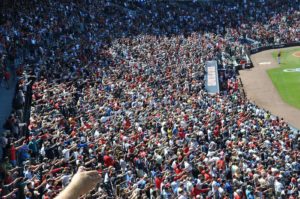Author: Erik Brady
This World Series offers only bad choices.
Do we cheer for the cheaters? Or root for the racists?
The Houston Astros got caught stealing signs some years back. That was bad.
The Atlanta Braves cling to their team name and their tomahawk chop. That’s worse.
You’ll see it all on display tonight when the Braves play Game Three at Truist Park, their first home game of the series — at least if they follow the pattern they have shown all season. Stadium operators blast a drumbeat over the public-address system as a computer-generated tomahawk chops on the scoreboard, and then Atlanta fans join in with a rhythmic forearm motion, which they gleefully perform to a sing-song soundtrack.
The Kansas City Chiefs do something similar, as you probably saw this month when the Buffalo Bills played in KC on Sunday Night Football. NBC’s cameras showed it all, with nary a mention from commentators about what the network was beaming into the nation’s family rooms.
That sort of tacit approval disturbs Theresa McCarthy, interim chair of the University at Buffalo’s new department of Indigenous Studies, which opens next school year.
That sort of tacit approval disturbs Theresa McCarthy, interim chair of the University at Buffalo’s new department of Indigenous Studies, which opens next school year.
“It’s incredibly racist and dehumanizing for people to behave like that, and how that behavior is condoned,” she says. “It is unconscionable that this level of racism can prevail in the year 2021, when we have had these global racial-justice movements underway and accelerating. I am trying to find the words. Unbelievable. It is unbelievable that this still persists.”
McCarthy is a member of the Onondaga Nation, Beaver clan citizen of Six Nations of the Grand River Territory in Ontario. This year mass graves with the remains of thousands of Indigenous children were uncovered in Canada at former residential schools. That’s where, decades ago, First Nations children who had been taken from their families were forced to live in boarding schools. (UB’s statement on the original discovery at Kamloops may be found here.)
“We think of that kind of atrocity as a thing of the past, but it is still reflected in this kind of condoned behavior” at ballgames, McCarthy says. “The mockery and the violence are not disconnected. To see how grown adults act in front of children, and the way it is allowed to be seen as normal behavior, is terrible — this level of dehumanization of living people.”
Such residential schools also existed in the U.S. In fact, so-called “civilization regulations” in the late 19th and early 20th centuries forbade Native Americans to speak their own languages or practice their religions. Not incidentally, this era of forced assimilation was the one in which Native team mascots came to be. The National League team in Boston — previously known by a number of names, including Red Caps and Beaneaters — became the Braves in 1912. The franchise would later move to Milwaukee and then, of course, to Atlanta.
The Cleveland Indians took that team name in 1915, but the franchise retired it at the close of this season. The Washington Football team jettisoned its team name last year. (Washington’s former team name was a slur in any context outside of potatoes; generic names such as Indians can be fine on their own, but not in the context of mascots for sports teams.)
Somehow Buffalo’s short-lived NBA franchise was named Braves. Club officials should have known better: The team began play in 1970, an era when Native Americans served notice on the broader culture that such mascots mock them.
The Atlanta club says it has approval of its team name from a leader of the Eastern Band of Cherokee Indians. Major League Baseball commissioner Rob Manfred noted as much the other day in defending the team name. “For me,” he said, “that’s kind of the end of the story.”
McCarthy finds that laughable: “They can say certain Indigenous people condone it, but they don’t represent everybody.”
The National Congress of American Indians, the nation’s largest and most representative American Indian and Alaska Native organization, has long opposed sports mascots that implicate Native Americans. “Since 1968,” the organization says, “NCAI has worked to eliminate Native-themed mascots from sports and to educate the general public about the psychological, social, and cultural harms these Native mascots cause Native peoples, particularly Native youth.”
Thousands of such mascots have gone by the wayside at high schools and colleges since NCAI began its campaign — including at Syracuse University in the 1970s, at St. Bonaventure University in the 1990s, and at Lancaster High School more recently.
Just this week, NCAI released this statement: “In our discussions with the Atlanta Braves, we have repeatedly and unequivocally made our position clear — Native people are not mascots, and degrading rituals like the ‘tomahawk chop’ that dehumanize and harm us have no place in American society.”
McCarthy says such open displays of ridicule are precisely why UB’s new department of Indigenous Studies is needed.
McCarthy says such open displays of ridicule are precisely why UB’s new department of Indigenous Studies is needed.
“We can really teach and educate why these practices are so deplorable,” she says. “We can think about their ramifications in broader contexts.”
That’s something to consider as the World Series moves to Atlanta. The truest thing at Truist Park is this: The tomahawk chop must go. And the team name with it.
Erik Brady was sports columnist at the Courier-Express when it folded in 1982. He retired in 2019 after 36 years as a sports reporter at USA Today.
Lead image: Fans of the Atlanta Braves doing the tomahawk chop during the last game of the 2010 MLB season | Wikimedia Commons | Author: Kyle James

